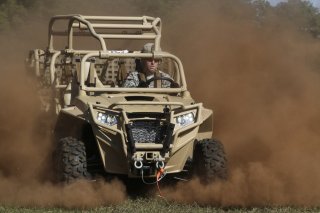The Army is Already Working on Electric Vehicles for its Climate Strategy
Army Secretary Christine Wormuth’s intent is to align environmentally-friendly adaptations with tactical, technological, and strategic warfighting improvements.
The Army’s new Climate Strategy explains how improvements that could decrease a vehicle’s emissions will also deliver combat advantages.
Many of those improvements center around the electrical systems and power sources for vehicles. One possibility is a hybridized vehicle that can run the vehicle’s systems without emitting sound or heat.
“Contemporary Army ground vehicles must continuously run their engines non-stop to power vital auxiliary systems like communications equipment even when the vehicle is not moving,” the document says. “Introducing anti-idle enables these systems to be powered even with the engine off, allowing the vehicle to serve its critical battlefield functions on ‘silent watch.’”
Paul Farnan, Acting Assistant Secretary of the Army for Installations, Energy and Environment, said that integrating electrical propulsion and functionality into heavy combat vehicles such as M1 Abrams tanks or M2 Bradleys Fighting Vehicles will happen on a “much longer timeline given all the issues that it is going to involve. We are going to push hard to get there, but be methodical and deliberate to do it.”
Army Secretary Christine Wormuth’s intent is to align environmentally-friendly adaptations with tactical, technological, and strategic warfighting improvements. That involves aligning the Army’s ongoing acquisition and modernization communities with the Installation, Energy, and Environment unit.
The Army’s new Climate Strategy is significant, but some technologies have precedent in previous modernization efforts. For instance, the Army’s Manned-Ground Vehicles developed for Future Combat Systems more than ten years ago were engineered with electricity and power-generating battery technologies. While batteries need to be properly cooled to function optimally, this innovation allowed vehicles to power and sustain onboard electrical systems like sensors, computers, and communications systems.
This is just one of many examples in which Army innovations explored for Future Combat Systems (FCS) wound up informing successful modernization efforts in subsequent years. While the ambitious FCS program was canceled in 2009 by former Secretary of Defense Robert Gates, many FCS-inspired technological breakthroughs wound up contributing to later modernizations. FCS technologies could now help with the hybridization of vehicles and electrical propulsion systems. The Climate Strategy will take time to implement, but the Army has some technologies that will help accelerate development for tactical vehicles and combat vehicles.
Hybridized vehicles need to be ruggedized for combat and able to preserve their weapons and warfighting advantages. One such vehicle, the Electric Light Reconnaissance Vehicle, is expected to enter testing in September 2023.
“Meanwhile, the Army is researching key questions about hybrid vehicle propulsion and power generation systems, developing advanced technologies, and working with vehicle Program Managers to integrate hybrid electric technologies into future and existing platforms,” the document says.
Kris Osborn is the Defense Editor for the National Interest. Osborn previously served at the Pentagon as a Highly Qualified Expert with the Office of the Assistant Secretary of the Army—Acquisition, Logistics & Technology. Osborn has also worked as an anchor and on-air military specialist at national TV networks. He has appeared as a guest military expert on Fox News, MSNBC, The Military Channel, and The History Channel. He also has a Master's Degree in Comparative Literature from Columbia University.
Image: U.S. Army Flickr.

